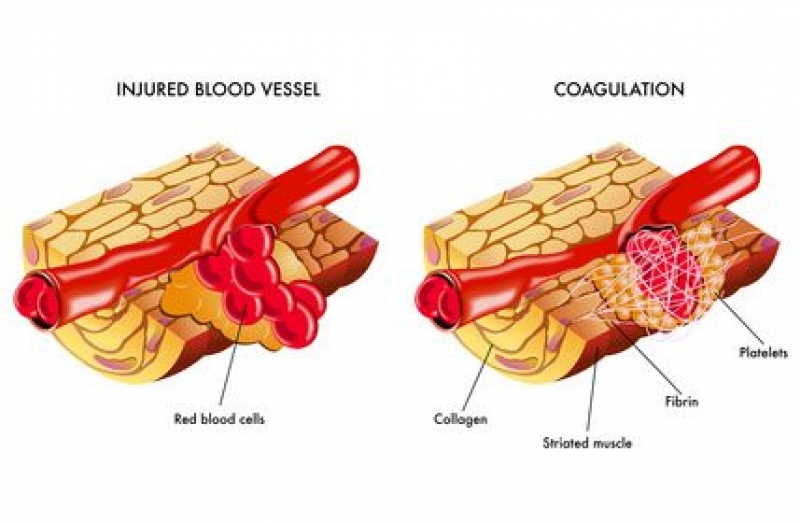Indice
- 1. Initiation and formation of the platelet plug
- 2. Propagation of the clotting process by the coagulation cascade
- 3. Termination of clotting by antithrombotic control mechanism
- 4. Removal of the clot by fibrinolysis
Physiopatology of haemostasis
Concetti Generali Di Emostasi

Haemostasis is the process by which the body controls the flow of blood following a vascular injury, forming a blood clot at the site of vessel injury. When a blood vessel wall is injured, a series of physiologic responses start to stop the local bleeding and to restore the initial conditions of the damaged vessel. When some of the elements involved in this process do not work correctely for genetic or acquired causes, or when some of these elements are absent for genetic causes, there will be a tendency to an abnormal bleeding or to a pathologic thrombosis causing a variety of congenital and acquired diseases. The key mechanism of this process is the formation of thrombin that acts on fibrinogen to generate the fibrin monomer, which rapidly polymerizes to form the fibrin clot that will be removed by plasmin induced lysis. Therefore an abnormal bleeding will be caused by a diminished thrombin formation as may happen for example in case of factor IX or factor VIII deficiency, or by an increased clot lysis as in case of α-2-antiplasmin deficiency and, on the contrary, a pathologic thrombosis will be caused by an increased thrombin formation as in case of inherited thrombophilia.
Hemostasis is a dynamic process that develops over time, beginning during intrauterine life and evolving throughout the neonatal period. Functional levels of coagulation proteins gradually increase during gestation and after birth, reaching near adult levels at approximately 6 months of age.
Although there are many schemes that describe hemostasis, in my opinion the best is the following that describes haemostasis in four phases : (1) (www.uptodate 2014)
1 ) Initiation and formation of the platelet plug
2 ) Propagation of the clotting process by the coagulation cascade
3 ) Termination of clotting by antithrombotic control mechanisms
4 ) Removal of the clot by fibrinolysis
Two outstanding papers published recently shed a new light on the understanding of haemostasis. One paper describes a new model of haemostasis in which fibrin formation appears to proceed via coagulation reactions on activated endothelium rather than on activated platelets. The authors show that prothrombinase bound in the vicinity of vascular damage is distributed away from platelets and is largely found on activated endothelium. Thus, platelets adherent to the site of vascular injury do not play a preeminent role in supporting prothrombinase assembly and thrombin formation. Rather the damaged activated endothelium and other blood cells play an unexpectedly important role in supporting prothrombinase assembly and function at the site of damage, providing a procoagulant surface. (2) (Blood 2014 vol. 124 (11) pp.1705-1714) The other paper shows that activated factor XI binds and proteolyzes tissue factor pathway inhibitor (TFPI) which is an essential reversible inhibitor of activated factor X (FXa) and also inhibits the VIIa-TF complex. The authors conclude that activated factor XI promotes factor X activation generation and fibrin formation through inactivation of tissue factor pathway inhibitor from platelets and on endothelial cells. The hemostatic role of factor XIa may be attributed not only to activation of factor IX, but also to promoting the extrinsic pathway of thrombin generation through inactivation of TFPI. (see section on" Propagation of the clotting process by the coagulation cascade" ). (3) (Blood 2015 vol. 125 (9) pp. 1488-1496)
Also recently, in march 2015, has been published a paper in which Choi and collegues have showed that polyphosphate released from platelets greatly accelerates factor V activation by factor XIa, while longer-chain polyphosphate released from damaged tissues or bacteria might provide even more effective FVa generation under pathologic conditions. (4) (Thrombosis and Haemostasis 2015 vol. 113 pp. 599-604) For details, see section on "Propagation of the clotting process by the coagulation cascade".
References :
1 ) Leung Lawrence L.K., Mannucci Pier Mannuccio, Tirnauer Jennifer S. :
Overview of hemostasis. www.uptodate.com 2014
2 ) Ivanciu Lacramioara, Krishnaswamy Sriram, Camire Rodney M. :
New insights into the spatiotemporal localization of prothrombinase in vivo. Blood 2014; 124 (11) : 1705-1714
3 ) Puy Cristina, Tucker Eril I., Matafonov Anton et al. : Activated factor XI increases the procoagulant activity of the extrinsic pathway by inactivating tissue factor pathway inhibitor. Blood 2015; 125 (9) : 1488-1496
4 ) Choi Sharon H., Smith Stephanie A. and Morrissey James H. : Polyphosphate accelerates factor V activation by factor XIa. Thrombosis and Haemostasis 2015; 113 (4) : 599-604